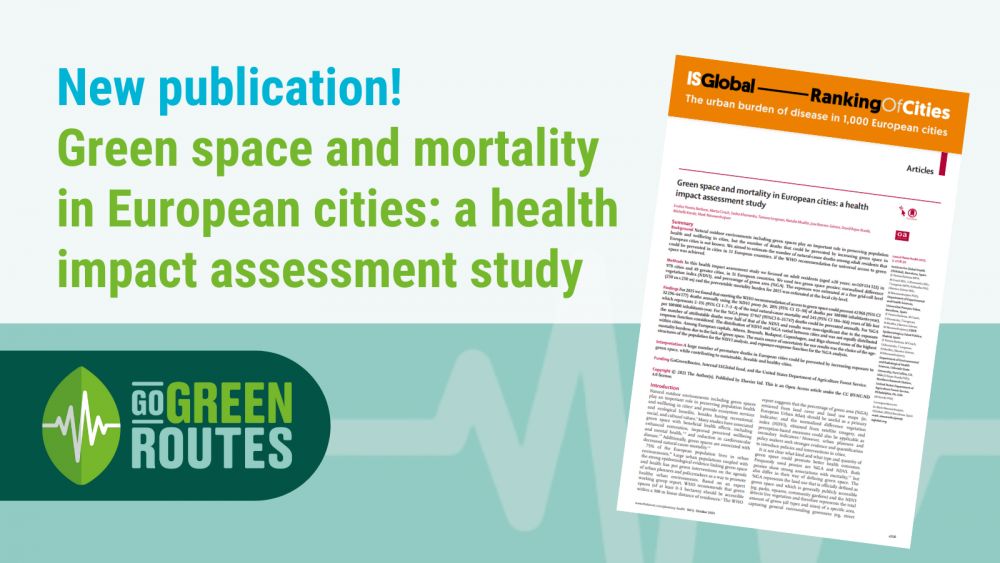Latest News
8 October 2021
Cities in Europe could prevent up to 43,000 deaths each year with more green spaces, study shows
Up to 43,000 premature deaths could be prevented each year if the WHO recommendations regarding residential proximity to green space were to be achieved in Europe, showed a new study co-funded by GoGreenRoutes.
The publication "Green space and mortality in European cities: a health impact assessment study", led by GoGreenRoutes project partner ISGlobal, analysed the amount of green space in more than 1,000 cities in 31 countries using the Normalised Difference Vegetation Index (NDVI) as the main proxy. The NDVI takes into account all types of vegetation, from street trees to private gardens, and is calculated using satellite images.
Green space is associated with a number of health benefits, including lower premature mortality, longer life expectancy, fewer mental health problems, less cardiovascular disease, better cognitive functioning in children and the elderly, and healthier babies. It also helps to mitigate air pollution, heat and noise levels, contributes to CO2 sequestration and provides opportunities for physical exercise and social interaction.
Based on a review of the scientific evidence, the WHO recommends universal access to green space and sets that there should be a green space measuring at least 0.5 hectares at a linear distance of no more than 300 metres from every home. On the basis of these guidelines and data from previous studies, the study estimated the mortality attributable to a lack of green space in 978 cities and 49 metropolitan areas.
The overall NDVI results showed that 62% of the population lives in areas with less green space than recommended. This lack of green space is associated with 42,968 deaths—2.3% of all deaths from natural causes—which could be prevented through compliance with the WHO recommendations.
“Our findings show that green space is very unevenly distributed across European cities, with mortality attributable to insufficient exposure to green space ranging from 0% to 5.5% of all natural deaths, depending on the city,” commented ISGlobal researcher Evelise Pereira, lead author of the study. “However, the uneven impact is not only between cities, but also between different areas within the cities, which puts some people at disadvantage, depending on which city or neighbourhood they live in. Too often green spaces are not close to where people live, and people don’t get the health benefits”, she added.
“This study provides an overview that shows that there is much work to be done in terms of re-greening cities and that the reduction of mortality could be even greater if we were to set more ambitious targets than the WHO recommendations,” remarked Mark Nieuwenhuijsen, Director of the Urban Planning, Environment and Health Initiative at ISGlobal and last author of the study.
“European cities should focus on reclaiming urban land for green space, introducing nature-based solutions such as green roofs and vertical gardens, and other measures such as rerouting traffic, digging up asphalt and replacing it with green space, green corridors, street trees and pocket parks across the board. Our study also shows that it is important that green spaces are accessible and close to residences,” added Nieuwenhuijsen.
The study is the second in a series dedicated to measuring urban exposures in European cities. A ranking of cities by mortality attributable to air pollution was published in January 2021. The data and lists for both rankings are available at www.isglobalranking.org.
Read the full study here.
Top 5 Cities With Highest Burden of Mortality
The 5 cities with more than 100,000 inhabitants with the highest mortality burden due to low normalised difference vegetation index (NDVI) are as follows:
| Rank | City | Country | Preventable deaths - NDVI | % of population below recommended levels |
| 1 | Trieste | Italy | 145 | 74% |
| 2 | Turin | Italy | 546 | 92% |
| 3 | Blackpool | United Kingdom | 144 | 73% |
| 4 | Gijón | Spain | 138 | 71% |
| 5 | Brussels | Belgium | 426 | 78% |
Top 5 Cities With Lowest Burden of Mortality
The 5 cities with more than 100,000 inhabitants with the lowest mortality burden due to low normalised difference vegetation index (NDVI) are as follows:
| Rank | City | Country | Preventable deaths - NDVI | % of population below recommended levels |
|---|---|---|---|---|
| 1 | Elche/Elx | Spain | 4 | 20% |
| 2 | Telde | Spain | 2 | 33% |
| 3 | Guimaraes | Portugal | 3 | 18% |
| 4 | Perugia | Italy | 10 | 31% |
| 5 | Cartagena | Spain | 10 | 51% |
Reference
Pereira Barboza E, Cirach M, Khomenko S, Iungman S, Mueller N, Barrera-Gómez J, Rojas-Rueda D, Kondo M, Nieuwenhuijsen M, Green space and mortality in European cities: a health impact assessment study, Lancet Planet Health 2021; 5: e718–30. https://doi.org/10.1016/S2542-5196(21)00229-1.


